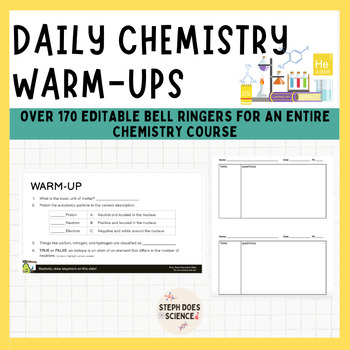Chemistry Warm-Ups
- PDF
Description
This is a set of 170+ chemistry warm-ups in Google slides format that are ready to use and fully editable. They can be used as entrance or exit tickets.
What's included?
- Student template
- 14 Google Slides presentations
- 170+ daily warm-ups with multiple questions per slide
- Teacher answer key on each slide + a detailed answer key with work for all math problems
Note: All slides are editable to fit your specific needs!
I typically have the warm-up projected and ready to go when my students enter the classroom. They complete the task while students trickle in, I take attendance, attend to any housekeeping tasks, etc. We always go over the answers together after about 5-10 minutes. I have found that this helps to focus students immediately and engage them in the content.
Different Formats
- Google slides - students can answer on their devices using Pear Deck or you can project the warm-up and have students answer on the template provided or in their notebooks
- PowerPoint - if you prefer PowerPoint over Google Slides, all you need to do is click file --> download --> .pptx to convert to PowerPoint.
Topics Covered:
Foundations of Chemistry Thermochemistry
Scientific Measurements Chemical Reactions
Matter and Change The Mole & Stoichiometry
Atomic Structure Solutions
The Periodic Table Reaction Rates
Ionic Bonds Equilibrium
Covalent Bonds Acids and Bases
Customer Service
If you have any questions, please feel free use the Ask a Question feature in TpT. My goal is to provide quality products and I will be happy to assist you with whatever you need or questions you may have.
LICENSING TERMS: This purchase includes a license for one teacher only for personal use in their classroom. Licenses are non-transferable, meaning they can not be passed from one teacher to another. No part of this resource is to be shared with colleagues or used by an entire grade level, school, or district without purchasing the proper number of licenses. If you are a coach, principal, or district interested in transferable licenses to accommodate yearly staff changes, please contact me for a quote at stephdoesscience@gmail.com.
COPYRIGHT TERMS: This resource may not be uploaded to the internet in any form, including classroom/personal websites or network drives, unless the site is password protected and can only be accessed by students.





